This whole series about Japanese textbooks is getting a bit out of hand. At this moment I cannot say out how many posts this series will exist. But that does not matter any more. Today I’m going to talk about listening- and speaking skills books. Books about this subject are harder to find, then books on other subject, especially if you look for beginner books. Here it is part 5, Japanese study book: listening & speaking
Japanese study book: listening & speaking
Nature vs. nurture
Listening is for one person a walk in the park and for others a mountain to concern. I, myself have more a visual memory. Listening is therefore something where I always feel that I’m a little bit behind. Speaking is not a problem, but my word are always coming quicker when I can write them first down.
How good or bad you are depends (partly) on your native language. When you speak a language that contain all the sounds that you need to speak Japanese, then you’re in luck . You recognize these sounds easily because you know them already. Remembering words and phrases are also easier because you do not need to concentrate on the sound and new words. You know the sounds so you can give all your attention to the rest.
Again…, beginner grammar books
Listening exercise are just as kanji and reading often incorporated in the beginners grammar books. Especially in the series ‘ A course in modern Japanese’ there is at the end of each chapter an extensive developed listening exercise . In the Genki-series is this not so extensively. At the beginning of each chapter you will find a dialogue that you can listen to.
Listening, not your strong point?
If You soon notice that listening is not your strong point . Perhaps you can look for additional material . Listening and talking are important skills. Even if you do not want it, you need to work on it, because it is quite important.
Listening & speaking books
Mastering Japanese bye ear

This book is perfect if you are a beginner. The listening exercises start at earliest beginnings of Japanese. First they focus on learning to recognize words and numbers. Each exercise also focuses only on one new grammatical point. So you can choose freely which exercise you want to complete.
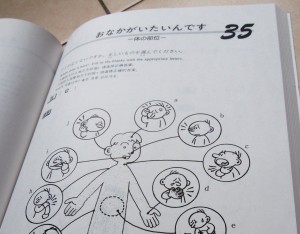
The book contains a total of 99 listening exercises. It’s not the first book you probably buy. But if you want to have additional listening exercises that are made for a beginner level, this book can be a good. You maybe will see that these exercises are used often in Japanese courses.
Using manga to understand practical Japanese honorific expressing, beginner level

Even if you only start learning Japanese many set of expressions are spoken in a polite form. Japanese has several levels of politeness. This is one of the reason why Japanese is not easy to learn. In the beginning you might not often recognize these different levels. This book is therefore ideal for a beginner, to learn to better understand, recognize, and perhaps apply them these differences.
For beginners and advanced students
The book is perfect for someone who is just starting to learn, but also perfect if you already have some knowledge. It’s divided in three main units; let’s speak, let’s listen, Keigo categories, after which it is further divided into smaller pieces.
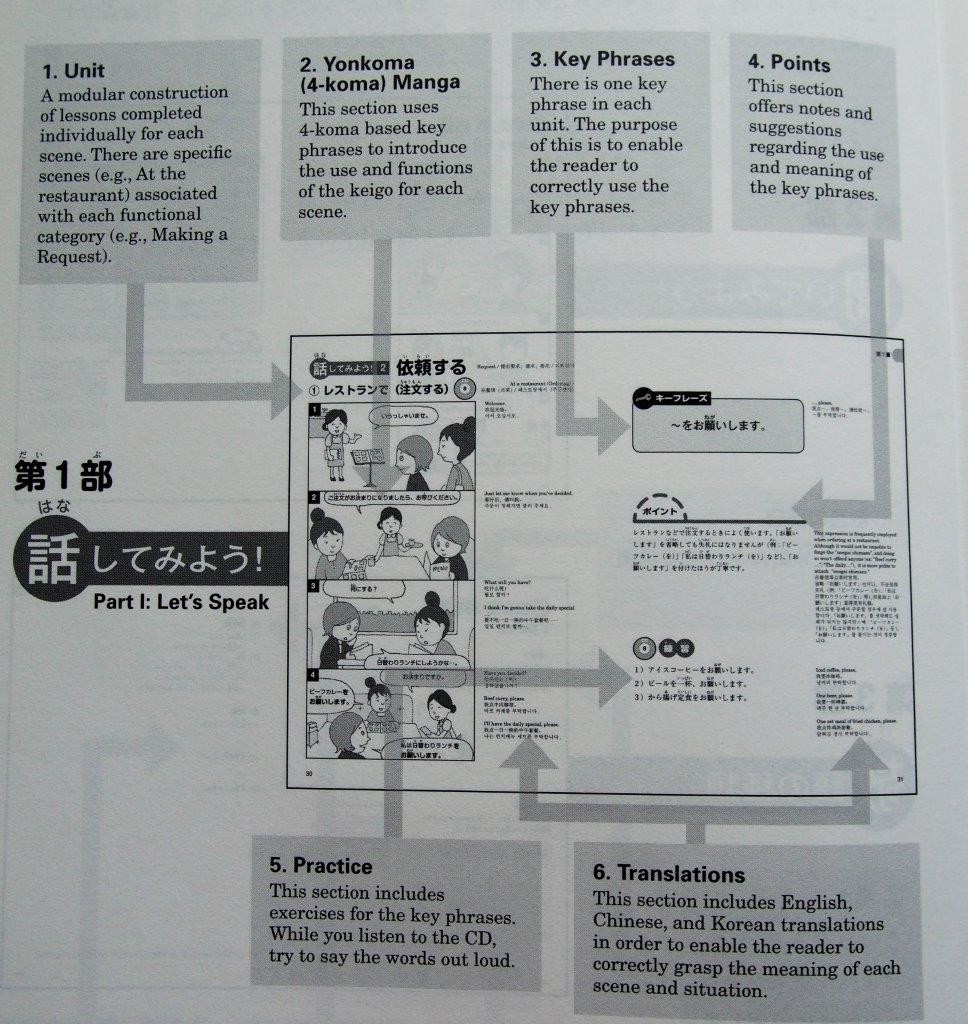
In unit 1 & 2 is every small part of the book discusses one key sentence. The function of the ‘key sentence’ is explained by a short strip (manga). You can also listen to the strip with the CD that is included. You find a brief explanation of the function of the honorific, Against which people you can use it and what is the less polite way to say this expression.
The explanation is in English or in Japanese. So if you already have progressed beyond the beginner level of Japanese grammar, you can try to understand the Japanese explanation. In the end there are always basic phrases in which the “key sentence” is used again. So you can hear the sentence in another context.
(Unit 3, the shortest unit in the book, explains the different levels of honorific. )
Let’s speak Japanese (Shadowing)
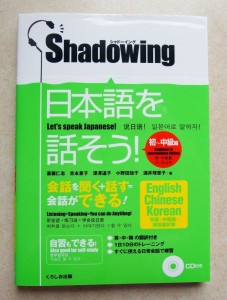
One way to improve your listening- and speaking skills is ‘Shadowing’. To say it short, you are going to try to recite a dialogues at the same time you listen to it.
How does it work?
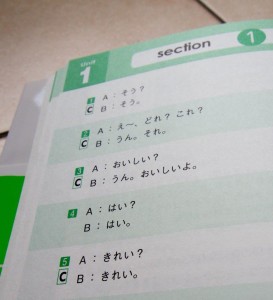
You start by learning the dialogues by heart. In the beginning, this is a very tiring process. You should listen to the text, and always try to repeat it as close as possible. The longer you try this method, the easier it goes. If you keep up with this method you will even understand texts you hear for the first time much better.
Why this book?
There are many books about this method, shadowing. I have chosen to purchase let’s speak Japanese. It’s a fun little book, that increases in difficulty, is a relaxed way to keep up with the method. The first exercise are basic words and not to complicated sentences. So you can start on a relax way trying this method. Towards the end of the book there are short dialogues.
The book recommends that you practice maximum 10 minutes each day. I think they are right, by exercising every day only 10 minutes you will not get tired of this and you will always find time to do this.
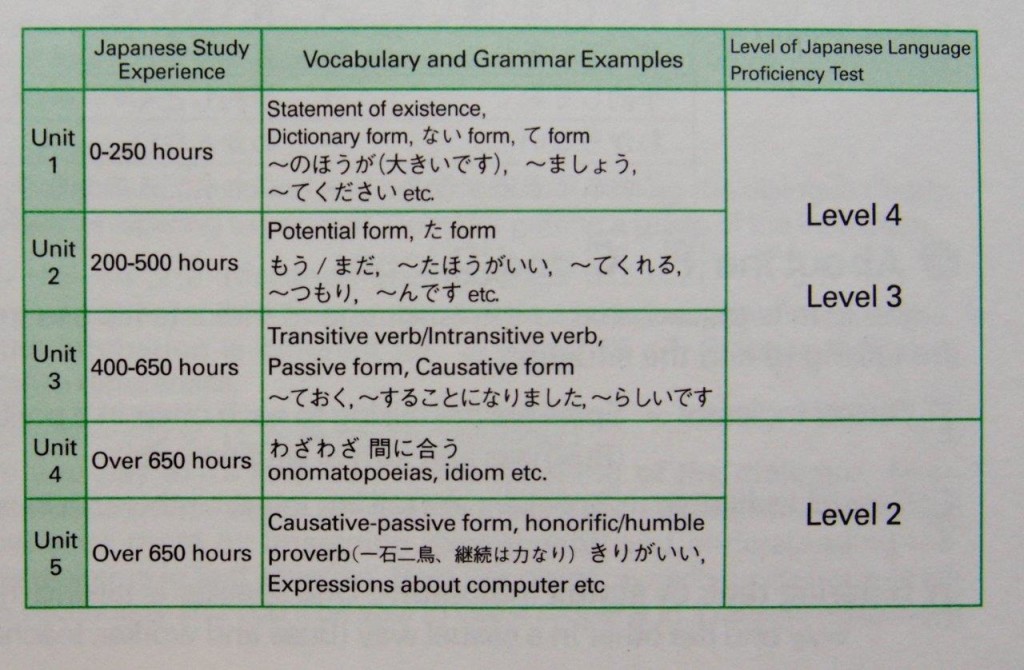
Speech for Basic Level Japanese
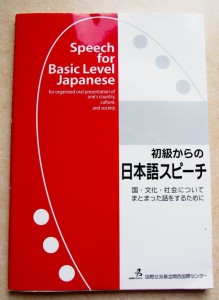
This is the only book that I own, where the focus is on improving your speaking skills. Speech contests are popular in Japan. This book teaches you how to prepare for a speech.
The book is therefore perfect to improve your speaking-skills (and maybe even your writing-skills). In a structured manner, you learn; how a good speech is constructed, which is a proper introduction, how to create a well-structured text and how to end a speech decently. Through different subjects, the level increases towards the end of the book. You’ll also find a treasure of new vocabulary related to the different subjects in this book. So you can learn words that you are not going to encounter everyday life in Japan.
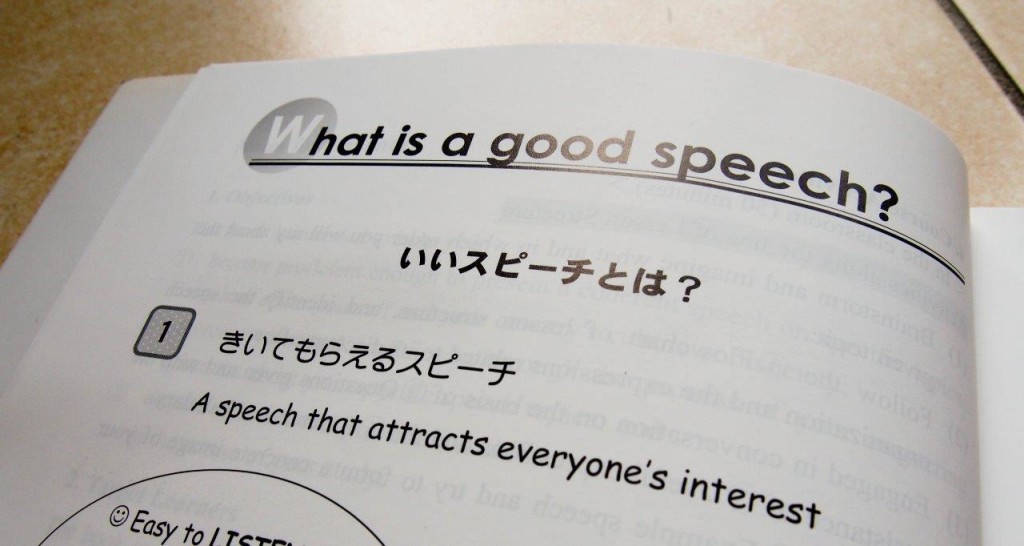
The book focuses mainly on speaking politely, everyday language is not covered in this book. But if you want to advance in the language you need to learn to master this polite way of speaking. If you are looking for everyday conversation it might be better to have a good language exchange partner where you regularly practice in Japanese.
Nihongo so Matome; listening comprehension
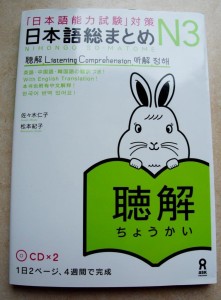
Also for the listening aspect of Japanese there is a book in the series Nihongo so Matome N3. This book is somewhat less comprehensive than the other books of the series. There are exercises for four weeks, while the other books have exercises for six weeks.
The first listening exercises focus mainly on spoken language . Starting from JLPT N3 there also more spoken language you need to understand. So you need to prepare for this . And just as in English and Dutch words are sometimes merged together and phrases are abbreviated. You need to learn to recognize these speech patterns .
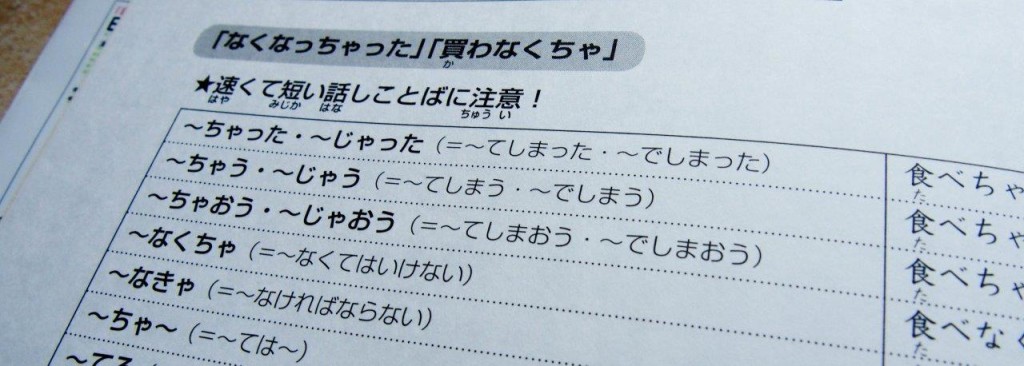
Topics range from conversations to communications that you hear in everyday life in Japan . You hereby also get a lot of new vocabulary that you cannot find it in the other books of this series .
Jazz up your Japanese onomatopoeia

This book is not really a book that helps you with increasing your listening skills. But because onomatopoeia is such a big part of the Japanese culture, I think this is the best place to put it. You will witness it everywhere where you go. So learn how to use them to can help you to integrated even better in the Japanese culture.
What is an onomatopoeia?
‘Pachi-pachi’, this is the sound of an applause, this is an onomatopoeia that is formed by imitation of a sound made by or associated with its referent.
An onomatopoeia is something we rarely use in the English or Dutch languages. Sometimes in a very energetic discussion we will accompanying a situation with sounds, but in general we use it rarely. In Japan, these onomatopoeia are really common. Both in manga, during conversations, on billboards or during television programs you will be confronted with them. Because sometimes it’s not obvious what the meaning is of the sound. They made this book to help you.
The perfect book!

Jazz up your Japanese onomatopoeia shows a variety of different themes of onomatopoeia that you can encounter when you are in Japan. Every chapter start out with a dialogue that contains different onomatopoeia. Then follows a translation of the dialogue and for each onomatopoeia a detailed description and a number of example sentences. At the end of each chapter there is a short quiz to see if you can place the onomatopoeia where they fit.
My opinion
This is a nice book to have as an extra. Do you want to concentrate on everyday conversations, or do you want to understand manga’s much better, this is a nice book to own. Everything is accompanied with furigana, and rōmaji. So this is a book for everyone to read.
Other post on Japanese study books:
- (Part 1): Kana
- (Part 2): Grammar
- (Part 3): Kanji
- (part 4): Reading
- (part 5): Listening and speaking *You are reading it*
- (Part 6): Dictionaries
- (Part 7): Where to buy?
If you have remarks, suggestions, or questions you can always post them in the comments section, on my Facebook page, Google+ page or through Twitter.
*Subscribe now on the weekly newsletter.
⇒
You can choose between ENG or the NL version*
(Look out for the confirmation mail to confirm!!)
[wysija_form id=”1″]